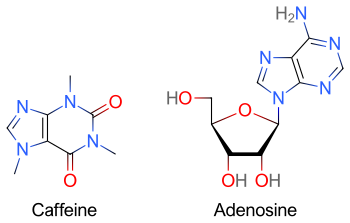Adenosine
 | |
 | |
| Clinical data | |
|---|---|
| Trade names | Adenocard; Adenocor; Adenic; Adenoco; Adeno-Jec; Adenoscan; Adenosin; Adrekar; Krenosin |
| Other names | SR-96225 (developmental code name) |
| AHFS/Drugs.com | Monograph |
| Pregnancy category |
(adenosine may be safe to the fetus in pregnant women) |
| Routes of administration | Intravenous |
| ATC code | |
| Legal status | |
| Legal status |
|
| Pharmacokinetic data | |
| Bioavailability | Rapidly cleared from circulation via cellular uptake |
| Protein binding | No |
| Metabolism | Rapidly converted to inosine and adenosine monophosphate |
| Elimination half-life | cleared plasma <30 seconds; half-life <10 seconds |
| Excretion | can leave cell intact or can be degraded to hypoxanthine, xanthine, and ultimately uric acid |
| Identifiers | |
| |
JSmol) | |
| |
| |
| | |
Adenosine (
Adenosyl (abbreviated Ado or 5'-dAdo) is the chemical group formed by removal of the 5′-hydroxy (OH) group. It is found in adenosylcobalamin (an active form of vitamin B12[1]) and as a radical in the radical SAM enzymes.[2]
Medical uses
Supraventricular tachycardia
In individuals with supraventricular tachycardia (SVT), adenosine is used to help identify and convert the rhythm.[3][4][5]
Certain SVTs can be successfully terminated with adenosine.
Fast rhythms of the heart that are confined to the
Because of the effects of adenosine on AV node-dependent SVTs, adenosine is considered a class V
Nuclear stress test
Adenosine is used as an adjunct to
Dosage
When given for the evaluation or treatment of a
The recommended dose may be increased in patients on theophylline since methylxanthines prevent binding of adenosine at receptor sites. The dose is often decreased in patients on
Drug interactions
Dipyridamole potentiates the action of adenosine, requiring the use of lower doses.

Caffeine acts by blocking binding of adenosine to the adenosine A1 receptor, which enhances release of the neurotransmitter acetylcholine.[14] Caffeine also increases cyclic AMP levels through nonselective inhibition of phosphodiesterase.[15] "Caffeine has a three-dimensional structure similar to that of adenosine," which allows it to bind and block its receptors.[16]
Contraindications
Common contraindications for adenosine include
- Asthma, traditionally considered an absolute contraindication. This is being contested, and it is now considered a relative contraindication (however, selective adenosine antagonists are being investigated for use in treatment of asthma)[17]
Pharmacological effects
Adenosine is an endogenous purine nucleoside that modulates many physiological processes. Cellular signaling by adenosine occurs through four known adenosine receptor subtypes (A1, A2A, A2B, and A3).[18]
Extracellular adenosine concentrations from normal cells are approximately 300 nM; however, in response to cellular damage (e.g., in inflammatory or
Adenosine receptors
All adenosine receptor subtypes (A1, A2A, A2B, and A3) are
Ghrelin/growth hormone secretagogue receptor
Adenosine is an
Mechanism of action
When it is administered intravenously, adenosine causes transient
The administration of adenosine also reduces blood flow to coronary arteries past the occlusion. Other coronary arteries dilate when adenosine is administered while the segment past the occlusion is already maximally dilated, which is a process called coronary steal. This leads to less blood reaching the ischemic tissue, which in turn produces the characteristic chest pain.
Metabolism
Adenosine used as a
When adenosine enters the circulation, it is broken down by adenosine deaminase, which is present in red blood cells and the vessel wall.
Adenosine deaminase deficiency is a known cause of immunodeficiency.
Research
Viruses
The adenosine analog
Such adenosine analogs are potentially clinically useful since they can be taken orally.Anti-inflammatory properties
Adenosine is believed to be an
Methotrexate's anti-inflammatory effect may be due to its stimulation of adenosine release.[33]
Central nervous system
In general, adenosine has an inhibitory effect in the central nervous system (CNS).
Hair
Adenosine has been shown to promote thickening of hair on people with thinning hair.
Sleep
Adenosine is a key factor in regulating the body's
A principal component of
Vasodilation
It also plays a role in regulation of blood flow to various organs through vasodilation.[43][44][45]
See also
- Adenosine receptor
- Adenosine reuptake inhibitor
- List of growth hormone secretagogues
References
- ISBN 3-540-33047-X.
- ISBN 0-7167-4339-6.
- S2CID 44107679.
- PMID 16525141.
- S2CID 21575090.
- PMID 19000353.
- ^ PMID 30725774. Retrieved 2022-01-28.
- ISBN 0-7923-6170-9.[page needed]
- PMID 1514488.
- ^ "2014 Guidelines" (PDF). regionsems.com. April 2016. Retrieved 10 April 2023.
- PMID 32166015.
- PMID 20164566.
- ^ "Vitamin B4". R&S Pharmchem. April 2011. Archived from the original on 2011-07-15.
- PMID 7752065.
- S2CID 235094871.
- ISBN 978-1-4641-8652-3.
- PMID 18311158.
- PMID 18758473.
- PMID 14698282.
- PMID 30513816.
- PMID 31878283.
- PMID 23601906.
- PMID 21917810.
- ^ ISBN 978-3-642-18999-9.
- ^ "Аденозин в косметике - Польза антивозрастной корейской косметики". KIMITO (in Russian). 2021-03-18. Retrieved 2021-03-22.
- ISBN 978-0-07-176402-5.
- PMID 8020339.
- PMID 19918064.
- PMID 15388457.
- PMID 24590073.
- PMID 18461129.
- PMID 18846036.
- PMID 21044428.
- PMID 12151508.
- PMID 11248116.
- S2CID 12289511.
- PMID 22020741.
- PMID 24183218.
- PMID 35575450.
- ^ "Adenosine and Sleep". Sleep Foundation. 2022-06-07. Retrieved 2023-04-12.
- ISBN 9781416066453.
- PMID 14746372.
- S2CID 71178.
- PMID 9576114.
- PMID 1884445.
